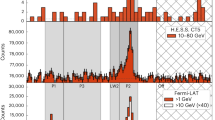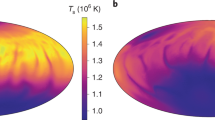Abstract
The 1.5-ms pulsar PSR1937 +214 has so far been observed only in the radio range1, and X-ray and γ-ray observations at energies of between ∼30 and 1,000 MeV have yielded only upper limits for the radiation flux1–3. An optical identification of the 1.5-ms pulsar has been proposed4, but this identification cannot yet be considered definite. Thus it is of great interest to determine in which spectral region the PSR1937 +214 pulsar shows a radiation maximum. Here I consider how the current pulsar theory answers this question, and show that the 1.5-ms pulsar should be an intense source of γ quanta with an energy of ∼1011 eV below which γ rays freely leave its magnetosphere. The flux of superhard γ quanta emitted by this pulsar may exceed, by an order of magnitude, the flux from the pulsar in the Crab Nebula.
This is a preview of subscription content, access via your institution
Access options
Subscribe to this journal
Receive 51 print issues and online access
$199.00 per year
only $3.90 per issue
Buy this article
- Purchase on Springer Link
- Instant access to full article PDF
Prices may be subject to local taxes which are calculated during checkout
Similar content being viewed by others
References
Backer, D. C., Kulkarni, S. R., Heiles, C., Davis, M. M. & Goss, W. M. Nature 300, 615–618 (1982).
Swanenburg, B. N. et al. Astrophys. J. Lett. 243, L69–L73 (1981).
Becker, R. H. & Helfand, D. J. Nature 302, 688–690 (1983).
Djorgovski, S. Nature 300, 618–619 (1982).
Ruderman, M. & Sutherland, P. Astrophys. J. 196, 51–72 (1975).
Hardee, P. E. Astrophys. J. 216, 873–880 (1977).
Erber, T. Rev. mod. Phys. 38, 626–647 (1966).
Sturrock, P. A. Astrophys. J. 164, 529–556 (1971).
Ochelkov, Yu. P. & Usov, V. V. Astrophys. Space Sci. 69, 439–460 (1980).
Lominadze, J. G., Machabeli, G. Z. & Usov, V. V. Astrophys. Space Sci. 90, 19–43 (1983).
Grindlay, J. E., Helmken, H. F. & Weeken, T. C. Astrophys. J. 209, 592–601 (1976).
Gupta, S. K. et al. Astrophys. J. 221, 268–273 (1978).
Arons, J. Proc. Workshop ‘Plasma Astrophysics’, Varenna, Italy, 273–286 (1981).
Arons, J. Proc. IAU Symp. 94, 175–203 (1981).
Author information
Authors and Affiliations
Rights and permissions
About this article
Cite this article
Usov, V. Expected high-frequency radiation from the 1.5-ms pulsar. Nature 305, 409–410 (1983). https://doi.org/10.1038/305409a0
Received:
Accepted:
Issue Date:
DOI: https://doi.org/10.1038/305409a0
This article is cited by
-
Spectral Constraints for Millisecond Pulsars Due to General Relativistic Frame Dragging
Astrophysics and Space Science (2005)
-
Implications of the detection of pulsed TeV gamma-rays from Geminga
Astrophysics and Space Science (1996)
-
Gamma rays from millisecond pulsars
Journal of Astrophysics and Astronomy (1991)
-
Pulsars: their origin and evolution
The Astronomy and Astrophysics Review (1989)
Comments
By submitting a comment you agree to abide by our Terms and Community Guidelines. If you find something abusive or that does not comply with our terms or guidelines please flag it as inappropriate.



